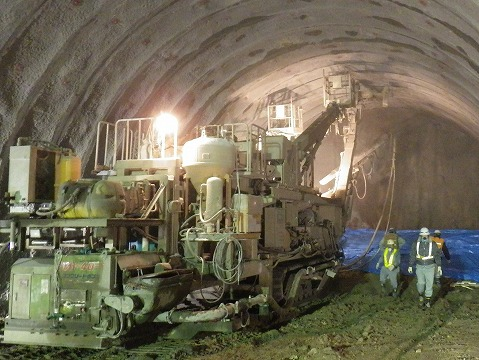Overview
 Photo 1 Construction status of low rebound sprayed concrete
Photo 1 Construction status of low rebound sprayed concrete
Sprayed concrete is concrete that is sprayed directly onto the ground after tunnel excavation to serve as a support material. When concrete is sprayed, bouncing (rebound) occurs. So far, various methods have been developed and put into practical use for the purpose of reducing the amount of rebound. For example, there is a method to increase the amount of powder such as cement or admixture (fly ash or ground granulated blast furnace slag). There are also methods to increase the viscosity of concrete and to add thickeners directly by using special machines. However, these methods require additional equipment separately, which increases the cost of materials and labor during construction, thus increasing construction costs.
This "Multi Effect method" can increase the viscosity of sprayed concrete and reduce the amount of rebound only by adding a special admixture, instead of the admixture required during concrete production, without changing the conventional mix proportioning and construction machinery, etc.
This "Multi Effect method" can increase the viscosity of sprayed concrete and reduce the amount of rebound only by adding a special admixture, instead of the admixture required during concrete production, without changing the conventional mix proportioning and construction machinery, etc.
Advantages
- The amount of rebound is reduced because moderate viscosity is added to the concrete and the material separation resistance of the aggregate is improved.
- Reduces the amount of dust that is harmful to humans and the environment generated when concrete is sprayed.
- Since the amount of water added during concrete mixing can be reduced, the strength of the concrete is increased and the durability and quality of the structure are improved.